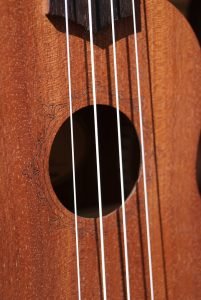So, you’ve picked up your ukulele, ready to strum away and create beautiful melodies. But wait, something’s not quite right. Your instrument is out of tune, and it’s time to fix it. In this article, we’ll show you how to tell if a ukulele is out of tune and provide you with simple steps to bring it back in tune.

How to Tell If a Ukulele Is Out of Tune – Key Takeaways
- Loose or slipping tuning pegs can cause a ukulele to be out of tune.
- Strings that sound flat or sharp when played indicate the need for adjustment.
- Proper finger placement and hand positioning are important for chord clarity and precision.
- Issues with harmonics can be caused by loose or tight strings, worn-out strings, incorrect bridge placement, or a poorly cut or worn-out nut.
Tuning Pegs Are Loose or Slipping
First, check if any of your tuning pegs are loose or slipping. Common causes of loose or slipping tuning pegs on a ukulele can include worn out screws or bushings, excessive tension on the strings, or a damaged gear mechanism.
To fix loose or slipping tuning pegs, start by tightening the screws on the pegs using a screwdriver or Allen wrench. If the pegs continue to slip, you may need to replace the bushings to ensure a proper fit. You can take your ukulele to a luthier at a store that specializes in instrument repairs. Make sure this store carries ukuleles and guitars so that you know they know what they are doing.
Additionally, you can try reducing the tension on the strings by loosening them slightly. If the gear mechanism is damaged, it may be necessary to replace the entire tuning peg.
Remember to be gentle and precise when making adjustments to avoid further damage to your ukulele.
Strings Sound Flat or Sharp When Played
One way on how to tell if a ukulele is out of tune is to listen for whether the strings sound flat or sharp when you play them. Here are some signs to look out for:
- Flat Sound: If the strings sound lower in pitch than they should be, they’re flat. This means they need to be tightened or adjusted to achieve the correct pitch.
- Sharp Sound: On the other hand, if the strings sound higher in pitch than they should be, they’re sharp. This indicates that they need to be loosened or adjusted to lower the pitch.

To address these issues and ensure better pitch, you can try the following:
- Tuning the ukulele using relative tuning methods. This involves tuning one string to a reference pitch and then using that string to tune the others.
- Tuning the ukulele with a clip-on tuner.
Chords Don’t Sound Clear or in Tune
If your ukulele is out of tune, you may notice that when you play chords, they don’t sound clear or in tune. This can be frustrating, but there are a few things you can do to improve the sound quality of your chords. One important factor is proper finger placement. When you place your fingers on the frets, make sure they are pressing down firmly and directly behind the frets. This will help produce a clear sound and prevent any buzzing or muted notes. Additionally, beginners often make mistakes when tuning their ukulele. Some common mistakes include not using a tuner, not properly tightening or loosening the strings, or not checking the tuning regularly. By avoiding these errors and practicing proper finger placement, you can achieve a clear and in-tune sound when playing chords on your ukulele.

Proper Finger Placement for Clear Chord Sound
- Press fingers firmly and directly behind frets
- Avoid buzzing or muted notes
- Practice correct hand and finger positioning
- Strive for clarity and precision
Harmonics Sound Off or Out of Tune
When your ukulele is out of tune, you may also notice that the harmonics sound off or out of tune, affecting the overall sound quality of your instrument. To ensure that your ukulele’s harmonics are in tune, it’s crucial to maintain proper ukulele maintenance and string tension.
Here are some factors that can cause harmonics to sound off:
- Loose or tight strings: Improper string tension can result in harmonics that are either flat or sharp.
- Worn-out strings: Over time, strings can lose their elasticity and become dull, causing the harmonics to sound muted or out of tune.
- Nut issues: A poorly cut or worn-out nut can also lead to harmonics that are out of tune.
Using a Ukulele Tuner to Check for Accuracy
Check your ukulele’s accuracy by using a tuner. A ukulele tuner is an essential tool for ensuring your ukulele is in tune and sounding its best. It provides precise measurements of the pitch of each string, helping you make adjustments as needed. While there are alternative methods on how to tune a ukulele without a tuner, using a tuner is the most accurate and convenient option. To help you understand the process better, here is a table outlining the standard tuning for a ukulele:
| String | Note |
| G | C4 |
| C | E4 |
| E | G4 |
| A | A4 |
When using a tuner, it’s important to avoid common mistakes such as plucking too hard, which can result in an incorrect reading. Additionally, make sure to tune each string individually and double-check the accuracy before moving on to the next string. By following these guidelines, you can confidently use a tuner to keep your ukulele in perfect tune.
You can also check an earlier post we made about tuning here.
Frequently Asked Questions
How Do I Tighten Loose Tuning Pegs on My Ukulele?
To tighten the tuning pegs on a ukulele, start by loosening the string by turning the peg counterclockwise. Then slowly start turning the tuning peg clockwise and watch the string tighten. Tighten to get the desired note on the tuner.
What Causes the Strings to Sound Flat or Sharp When Played?
When playing the ukulele, you might notice that the strings sound flat or sharp. This can be caused by various factors, such as temperature changes, improper string tension, or worn-out strings. To fix tuning issues, you can adjust the tuning pegs or replace the strings.
Why Do the Chords on My Ukulele Sound Unclear or Out of Tune?
To properly tune your ukulele for clear and accurate sound, it is important to identify common causes of unclear or out-of-tune chords. This will ensure that you can play with freedom and precision.
Can You Provide Some Tips on Using a Ukulele Tuner to Check the Accuracy of a Ukulele’s Tuning?
To check the accuracy of your ukulele’s tuning, use an electronic tuner and carefully follow the instructions. These types of tuners are relatively easy to use. You can also look for online tuners that generate a precise note electronically.
Conclusion
In conclusion, when it comes to determining if a ukulele is out of tune, there are several signs to look out for.
Loose or slipping tuning pegs, flat or sharp sounding strings, unclear chords, and off harmonics are all indicators of a ukulele needing to be tuned.
To ensure accuracy, using a tuner is recommended.
By paying attention to these details and regularly tuning your ukulele, you’ll be able to produce beautiful and precise music that will resonate with your audience.

Are you struggling with strumming?
With our book and course, you’ll become a fluent 3-chord strummer.




